Vaikrutapaha Meaning, Types, Clinical Significance
By Dr Raghuram Y.S. MD (Ay) & Dr Manasa, B.A.M.S
Vaikrutapaha is the seventh and final form of treatment included in the ‘Sapta Upakrama’ i.e. 7 types of treatments explained by Master Sushruta. Along with the other six forms of treatment it aims at healing and treating the ulcers, wounds and swelling and to prevent its complications. These procedures are done after Shodhana and Ropana. If the condition of the wound / ulcer or swelling available to the physician at the time of treating the patient is fit to undergo one of these therapies directly, they shall be skillfully chosen.
Read – Sushruta’s 7 Types of Treatments Sapta Upakrama
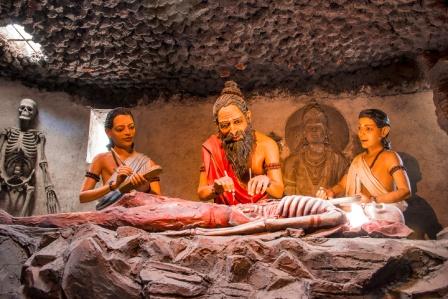
Table of Contents
Vaikrutapaha
“Finally (following the chronology) Vaikrutapaha (seventh treatment amongst the seven treatments) should be done…!”
Vaikritapaha means removing the deformities or undesired changes which have occurred as complications or sequels of wounds. So after having done cleansing and healing methods or in fact the earlier 6 kinds of treatments of sapta upakrama, vaikretapaha is done to treat or remove the residual deformities or sequels of ulcers or wounds which are left over.
Sanskrit Verses
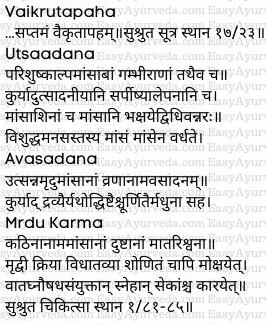
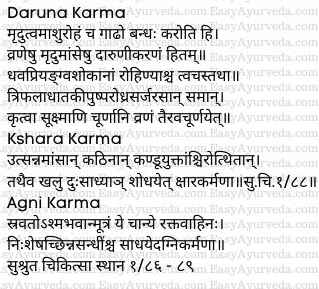
Read – Charaka Vrana Chikitsa – 25th Chapter – Wounds, Ulcers
Types
Mainly 26 treatments are included under Vaikrutapaha from amongst the 60 treatments mentioned in Shashti Upakrama. They are –
| Sl No | Name of the Upakrama (treatment) | Meaning |
| 1 | Utsaadana | Elevation of wounds |
| 2 | Avasaadana | Depression of wounds |
| 3 | Mrudu Karma | Softening the edges of the wounds |
| 4 | Daaruna Karma | Hardening the margins of the wounds |
| 5 | Kshara Karma | Application of alkalis / alkali cauterization |
| 6 | Agni Karma | Application of fire / fire cauterization |
| 7 | Krshna Karma | Inducing black color |
| 8 | Pandu Karma | Inducing white color |
| 9 | Pratisaarana | Rubbing tablets made up of rough medicinal powder on the ulcer |
| 10 | Roma Sanjanana | Treatments and medicines (measures) enabling growth of hairs |
| 11 | Loma Apaharana | Treatments and medicines (measures) enabling removal of unnecessary hairs |
| 12 | Vasti Karma | Medicinal Enemas |
| 13 | Uttara Vasti Karma | Enemas given through urinary and genital passages |
| 14 | Bandha | Bandages |
| 15 | Patra Daana | Covering the wounds with leaves |
| 16 | Krimighna | Disinfectants |
| 17 | Brmhana | Bulk promoting and strengthening treatments |
| 18 | Vishagna | Anti-toxins |
| 19 | Shiro virechana | Nasal instillation of medicines / head cleansing |
| 20 | Nasya | Nasal instillation of medication / Errhines |
| 21 | Kavala dharana | Rinsing of mouth with medicinal liquids |
| 22 | Dhooma | Fumigation |
| 23 | Madhu sarpi | Administration of honey and ghee |
| 24 | Yantra | Instrumentation |
| 25 | Aahara | Dietetic regimen |
| 26 | Rakshaa vidhana | Sterilization |
1. Utsaadana – elevation of ulcer
This includes the treatment of wounds / ulcers so as to improve the granulation tissue and also to raise the floor of the wound. This is done when wound area is depressed. Utsadana is opposite of Avasadana (depression of wounds – explained below).
Conditions in which wounds need to be elevated –
- Parishushka – dried ulcers and wounds
- Alpa mamsanam – ulcers covered with less muscles (most muscles have been destroyed)
- Gambhiranam – deep seated ulcers
In these conditions the ghee and anointments prepared with the herbs used for elevating the wounds are administered. The patients are fed with the meat of carnivorous animals. By the consumption of such meat the mind of the person gets devoid of unwanted emotions like anger, grief etc. This will further facilitate and hasten the growth of the muscles and elevation of the depressed ulcers.
Read – Foods That Increase Sattva, Rajas, Tamas: Srimad Bhagavat Geeta
2. Avasadana – depression of ulcers
This includes the measure used for the removal of unhealthy, unnecessary, hyper-granulation tissue from floor of the wound so as to cause their depression and make the surface of the ulcer even. This is administered in cases where the ulcers / wounds are elevated above the surface of the skin. Avasadana is opposite of Utsadana (explained above).
Conditions in which wounds need to be depressed –
Utsanna mrdu mamsa – ulcers surrounded by elevated and smooth muscles should be depressed with medicines used for depressing the ulcers mixed with honey.
3. Mrdu Karma – softening the edges of the ulcers
Conditions in which the edges of the ulcers need to be softened –
- Kathinanam – hard ulcers
- Amamsanam – ulcers having less or no muscles around (wasting or destruction of muscles)
- Dushtanam matarishvanaa – ulcers which are contaminated by vitiated vata
In ulcers associated with the above mentioned conditions, treatments and medicines for softening the edges of the ulcers should be administered.
Along with this the below mentioned interventions too shall be included –
- Shonita mokshana – bloodletting
- Vataghna aushadha samyuktan snehan – fats (oils, ghee) prepared with vata alleviating herbs
- Seka – showering the ulcers with fluids prepared with vata alleviating herbs
Read – Vimlapana: Softening of Wounds, Ulcers – Types, Clinical Significance
4. Daruna Karma – hardening the edges of the ulcers
Some ulcers / wounds have less tensile strength so that the wound margin easily separate. This causes early dehiscence and wound healing delayed. To avoid long time wound healing, daaruna karma i.e. hardening the wound margins is done.
Conditions in which the edges of the ulcers need to be hardened –
- Mrudutvam ashu roham cha gaadho bandhah karoti hi – when the ulcers become smooth and heal quickly owing to them being bandaged regularly
- Mrdu mamseshu vraneshu – ulcers having soft muscles
Equal portions of the smooth powder of the below mentioned ingredients should be sprinkled on these ulcers to make them hard –
- Dhava – Anogeissus latifolia
- Priyangu – Callicarpa macrophylla
- Ashoka – Saraca asoca
- Rohini twak – bark of Picrorhiza kurroa
- Triphala – fruits of Terminalia chebula, Terminalia bellirica and Emblica officinalis
- Dhataki Pushpa – flowers of Woodfordia fruticosa
- Lodhra – Symplocos racemosa
- Sarjarasa – Vateria indica
5. Kshara Karma – application of alkalis / alkali cauterization
Conditions in which alkali needs to be applied in treating the ulcers –
- Utsanna mamsan – ulcers with elevated muscles in their vicinity
- Kathinan – hard ulcers
- Kandu yuktan – ulcers associated with itching
- Chirotthitan – ulcers which are persisting for a long time (chronic ulcers / wounds)
- Dusadhyan – ulcers which are difficult to cleanse and treat
6. Agni Karma – fire cauterization
Conditions in which fire cauterization applied to treat ulcers –
- Sravato mutran – ulcers discharging urine
- Ashma bhavan – ulcers caused by stones in the urinary tract (alternatively we can understand combining both these points as – ulcers formed by stones in the urinary tract which leads to discharge / dribbling of urine)
- Raktavahinah – bleeding ulcers
- Nishesha chinna sandheen cha – ulcers which are associated with completely destroyed (crushed) joints
Read – Sushruta’s 8 Types Of Surgical Procedures – Astavidha Shastra Karma
7. Krishna Karma – inducing black color
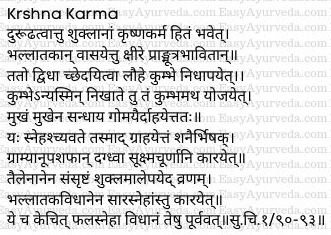
This treatment is conducted to make the hypo-pigmentation areas caused by ulcers normal like surrounding tissue.
Conditions –
Durudhatvat tu shuklaanaam – Black color shall be induced in the ulcers which have become white due to improper healing.
Method of inducing black color in the ulcers
Bhallataka (Semecarpus anacardium) which has been kept in the cow urine for seven days is then kept dipped in the milk for seven days.
Bhallataka is then cut into two pieces and placed in an iron vessel. The orifice of this vessel is kept over the opening of another vessel of similar size. The junction of both these vessels is sealed and the entire apparatus is kept in the pit. On the top of this dry pieces / cakes of cow-dung are placed and lit with fire. Due to the heat, Bhallataka melts and its oil is accumulated in the lower pot.
To this oil, fine powder of the hoofs of animals living in the villages and marshy areas are added and mixed thoroughly. The resultant mixture is applied on the ulcers which have become white.
8. Pandu Karma – inducing white color
This treatment is conducted to make the hyper-pigmented areas caused by ulcers normal like surrounding tissue.
Conditions –
Durudhatvat tu krshnanam – White color (normal skin color) shall be induced in the ulcers which have become black due to improper healing.
Method of inducing normal color in the ulcers
1. The fruit of Rohini – type of Terminalia chebula is kept in goat’s milk for 7 days and ground with the same milk to prepare its paste. This paste is applied on the hyper-pigmented ulcers which need to be brought to normal color.
2. The below mentioned ingredients should be mixed with honey and applied on the ulcer –
- Kapalika Churna – powder of plate of earthen pot
- Baidula – part of a reed called vidula / bamboo?
- Sarjarasa – Vateria indica
- Kasisa – green vitriol
- Madhuka – Glycyrrhiza glabra
3. The pulp from inside of Kapittaha fruit (Feronia linonia) is removed. The hollow of the fruit is filled with goat urine. Later the powder of the below mentioned are added –
- Kasisa – green vitriol
- Gorochana – bezoar
- Tuttha – purified copper sulfate
- Haratala – orpiment
- Manashila – realgar
- Venu nirlekhanam – bamboo bark
- Chakramarda bija – seeds of Cassia tora
- Rasanjana – extract of Berberis aristata
This fruit is buried in the ground, beneath the root of Arjuna (Terminalia arjuna) tree for one month and left in place. The resultant medicine should be applied on the ulcer for more than one month time period.
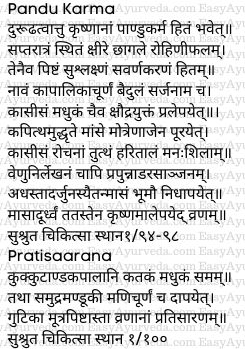
9. Pratisaarana
In this, the tablets prepared from rough powder of medicinal herbs are rubbed on the shiny skin after wound healing has occurred. This is done to make the skin surface rough and just like the normal texture of the skin.
The powders of the below mentioned ingredients taken in equal quantity are mixed and ground with cow urine and tablets are prepared –
- Kukkutanda kapalani – pieces of outer shell of egg
- Kataka – Strychnos potatorum
- Madhuka – Glycyrrhiza glabra
- Samudra Manduki / Mukta Shukti – Oyster shell
- Mani – alum, pearl etc
This tablet is rubbed on the ulcers.
10. Roma Sanjanana – enabling growth of hairs
a. The tusks of elephant are burnt and their ash prepared. To this good quality Rasanjana – extract of Berberis aristata is added and mixed with goat milk. When applied this medicine even produces hairs on the hands (palm).
b. Skin, hairs, hoof, horns and bones of animals are burnt to ash and mixed with oil. When this is applied it produces hairs.
c. Kasisa – green vitriol and leaves of Karanja – Pongamia pinnata are ground in the juice of Kapittha would produce hairs when applied.
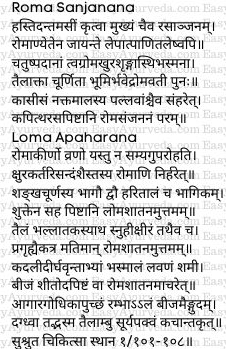
11. Loma Apaharana – removal of unnecessary hairs
Conditions –
When lots of unnecessary hairs grow in the site of ulcer they come into the way of ulcer healing. These hairs should be cut and trimmed using scalpel and forceps and thoroughly removed.
- Powder of conch shell and Haratala – orpiment taken in equal proportions are ground with sour fruit juices and applied. This will help in removal of unwanted hairs.
- Oil of Bhallataka and latex of Snuhi (Euphorbia neriifolia) are mixed together and applied to remove unwanted hairs.
- Ash of kadali – plantain and stem bark of Aralu – Ailanthus excelsa are mixed with Haratala – orpiment, Rock salt and seeds of shami and ground with cold water. This is applied to remove unwanted hairs.
12. Vasti Karma – herbal enemas
Conditions wherein herbal enemas shall be administered in treating ulcers –
- Vata dushto – ulcers contaminated by vitiated vata
- Rukshah – dried ulcers
- Atyartha vedinah – ulcers associated with severe pain
- Adhah kaye visheshena – ulcers manifesting in the lower parts of the body
Read – Basti treatment procedure, Benefits- Astangahrudayam Sutrasthana 19
13. Uttara Vasti Karma – urinary and genital enema
Conditions in which enemas should be administered through urinary and genital tracts –
- Mutraghata – obstruction of urine
- Mutra dosha – contamination of urine
- Shukra dosha – contamination of semen
- Ashmari janya vrana – ulcers caused by urinary calculi
- Artava dosha – contamination of menstrual blood
Read – Uttara Basti: Method, Indications, Mode of Action
14. Bandha – bandages
Benefits of bandaging the ulcers / wounds –
- Shudhyati vrano – wounds get cleansed
- Yati cha mardavam – ulcers / wounds become smooth
- Rohatyapi – the healing would occur comprehensively
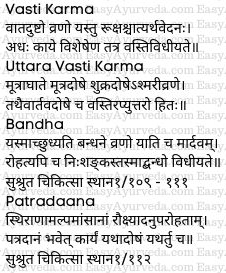
15. Patradaana – covering the wounds with leaves
Conditions in which the ulcers need to be covered with leaves –
- Sthiranam – immobile ulcers / wounds
- Alpa mamsanam – ulcers / wounds covered with less / scanty muscles
- Raukshyaad anuparohataam – wounds / ulcers which have not healed due to extreme dryness in them
In the above said conditions the leaves are used to cover the ulcers / wounds in accordance to the doshas involved and the seasons. Leaves having medicinal properties is covered on the wounds after having applied medicinal pastes on them.
16. Krimighna – disinfectants
When the flies and other insects sitting on open ulcers / wounds produce worms / germs they would bite the ulcers leading to swelling (inflammation) which is severely troublesome. Consequently severe and different kinds of pains and bleeding occur from the wounds. In this condition Surasadi Gana group of herbs are used washing the ulcers and healing them.
The below mentioned herbs shall be ground in cow’s urine and applied over the ulcers –
- Saptaparna – Alstonia scholaris
- Karanja – Pongamia pinnata
- Arka – Calotropis gigantea
- Neem
- Rajadana twak – bark of Alstonia venenata
Alternatively the wounds shall be washed with alkali water or the ulcers are showered with the same. The ulcers / wounds are covered with muscles / flesh which would attract the worms from inside the ulcers. This is a method of de-worming the ulcers and wounds.
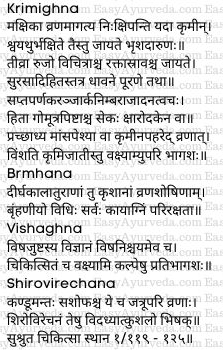
17. Brmhana – bulk promoting treatments
Conditions for administering bulk promoting / strengthening treatments for ulcer / wound healing –
- Dirgha kala aturanam – ulcers persisting for long time (chronic ulcers) or for a person suffering from diseases for long time
- Krshanam – emaciated persons
- Vrana shoshinaam – those who are debilitated due to the ulcers
In the above said conditions all kinds of bulk promoting / strengthening treatments shall be administered protecting one’s digestive fire (capacity).
Read – Brumhana Therapy – Nourishing Ayurvedic Treatment Principle
18. Vishaghna – anti-toxins
This includes treatments which nullify or neutralize the effect of poisons and toxins on ulcers / wounds.
The symptoms caused after consuming poisonous foods and drinks, examination of various types of toxins / poisons and their treatment are explained in detail in the Kalpa Sthana Section of Sushruta Samhita and hence not detailed in this context.
19. Shirovirechana – nasal instillation of medicines
Conditions –
- Kandumantah – ulcers associated with itching
- Sa shophascha – ulcers associated with swelling
- Jatrupari vranah – ulcers and wounds occurring above the level of collar bones / ulcers and wounds occurring at the junction of / joints of bones of neck, scapula and chest
Read – Shirovirechanopaga Gana – Herbs useful in Nasya treatment (nasal drops)
20. Nasya – nasal instillation of medicines / errhines
Conditions for administering errhines in ulcers / wounds –
- Rujavanto – ulcers associated with pain
- Anilaveshta – ulcers afflicted by vitiated vata
- Ruksha – dry ulcers
- Urdhwa jatruga vrana – ulcers located above the level of clavicle
In these conditions unctuous errhines should be administered.
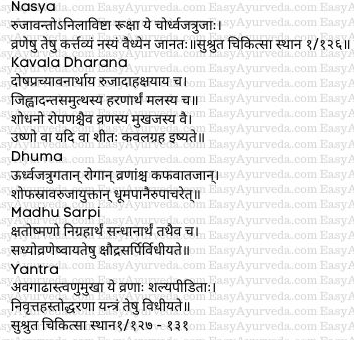
21. Kavala Dharana – rinsing of mouth with medicinal liquids
Conditions for administering mouth rinse in ulcers / wounds –
Hot and cold (as per condition) medicinal liquids should be used for mouth rinsing for the below mentioned purposes –
- Dosha prachyavanartham – to expel the morbid doshas
- Ruja daha kshayaya cha – reduce the pain and burning sensation associated with ulcers
- Jihva danta samutthasya haranaartham malasya cha – remove the wastes from the tongue and teeth and to cleanse them
- Shodhana ropanascha eva vranasya mukhajasya vai – for cleansing and healing the ulcers occurring in the oral cavity
Read – How To Do Oil Pulling In Genuine Ayurvedic Way?
22. Dhuma – fumigation
Conditions in which fumigation should be done to treat the wounds / ulcers –
- Urdhwa jatru gatan – diseases occurring above the level of clavicles
- Kaphavata janya vranan – ulcers / wounds caused by vitiated kapha and vata
- Shopha srava ruja yuktan – ulcers / wounds associated with swelling (inflammation), discharges and pain
Read – Dhoopana (Fumigation) Blends, Benefits, Procedure, Mode of Action
23. Madhu Sarpi – use of honey and ghee
Conditions –
- Kshatoshmano nigrahartham – to control the heat generated by the injury / trauma
- Sandhanartham – for unification
- Sadhyo vraneshu ayatesu – in freshly formed wounds / ulcers and in large ulcers
24. Yantra – instrumentation
Conditions wherein instruments are used in treating ulcers –
- Avagadha – deep seated ulcers / wounds
- Anu mukha – ulcers having minute opening
- Shalya piditah – ulcers / wounds containing foreign bodies in them
- Nivrutta hastoddharana – when the foreign bodies inside the ulcer / wound cannot be removed by hands
Read – Yantra Instruments used in Ayurveda: Ashtanga Hrudayam Sutrasthana 25
25. Ahara – dietetic regimen
A wise physician should advice lesser quantity of foods which are light for digestion to all the patients suffering from ulcers / wounds.
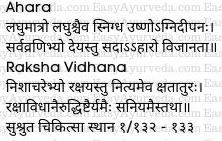
Read – Importance Of Diet (Pathya) For Specific Diseases
26. Raksha Vidhana – Sterilization
This includes sterilization of the surgical wards and instruments through the methods of fumigation with herbs like Guggulu (Commiphora mukul) etc and by Mantra Uccharana i.e. reciting holy hymns so as to kill the small pathogenic organisms. For the same purposes yama and niyama are also followed.
Summary
Above mentioned are the 26 treatment procedures which are meant for removing the deformities and undesired changes which have occurred as complications of wounds. They shall be used skillfully either individually or in combinations as and when required depending on the state and stage of ulcer / wound presented at the time of treatment.
Click to Consult Dr Raghuram Y.S. MD (Ayu)









